Hyundai i-30: Driver assist system / Parking Distance Warning (Reverse/Forward) system
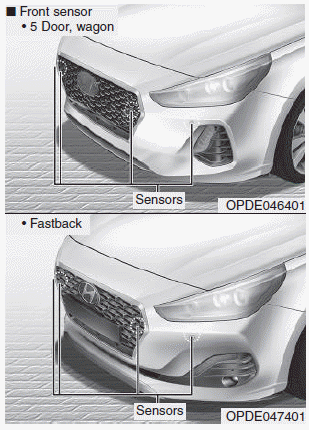
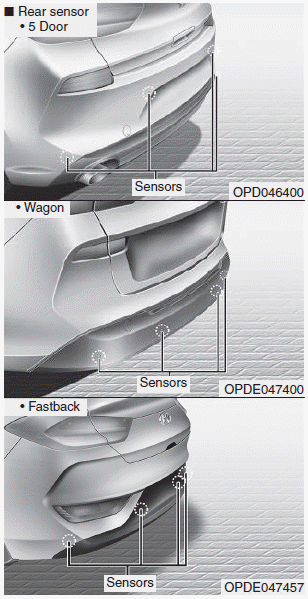
The Parking Distance Warning (Reverse/Forward) system assists the driver during movement of the vehicle by chiming if any object is sensed within the distance of 100 cm (39 inches) in front and 120 cm (47 inches) behind the vehicle.
This system is a supplemental system that senses objects within the range and location of the sensors, it cannot detect objects in other areas where sensors are not installed.
WARNING
- ALWAYS look around your vehicle to make sure there are no objects or obstacles before moving the vehicle in any direction to prevent a collision.
- Always pay close attention when the vehicle is driven close to objects, particularly pedestrians, and especially children.
- Be aware that some objects may not be visible on the screen or be detected by the sensors, due to the objects distance, size or material, all of which can limit the effectiveness of the sensor.
Operation of the Parking Distance Warning (Reverse/Forward) system
Operating condition
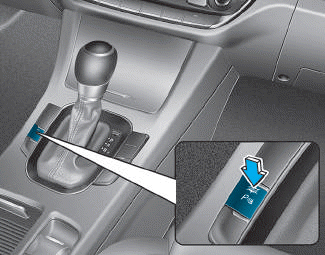
- This system will activate when the Parking Distance Warning (Reverse/Forward) system button is pressed with the engine running.
- The Parking Distance Warning (Reverse/Forward) button turns on automatically and activates the Parking Distance Warning (Reverse/Forward) system when you move the shift lever to the R (Reverse) position. However, if vehicle speed exceeds 6 mph (10 km/h), the system will not warn you even though objects are detected, and if vehicle speed exceeds 12 mph (20 km/h), the system will turn off automatically. To turn on the system, press the Parking Distance Warning (Reverse/Forward) system button.
- When more than two objects are sensed at the same time, the closest one will be recognised first.
Types of warning sound and indicator
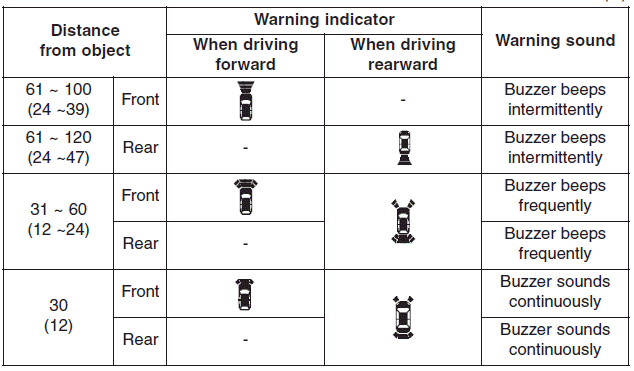
NOTICE
- The indicator may differ from the illustration depending on objects or sensors status. If the indicator blinks, we recommend that the system be checked by a HYUNDAI authorised repairer.
- If the audible warning does not sound or if the buzzer sounds intermittently when shifting into R (Reverse) position, this may indicate a malfunction with the Parking Distance Warning (Reverse/Forward) system. If this occurs, we recommend that you have your vehicle checked by a HYUNDAI authorised repairer as soon as possible.
Non-operational conditions of Parking Distance Warning (Reverse/Forward) system
Parking Distance Warning (Reverse/Forward) system may not operate normally when:
- Moisture is frozen to the sensor.
- Sensor is covered with foreign matter, such as snow or water, or the sensor cover is blocked.
There is a possibility of Parking Distance Warning (Reverse/Forward) system malfunction when:
- Driving on uneven road surfaces such as unpaved roads, gravel, bumps, or gradient.
- Objects generating excessive noise such as vehicle horns, loud motorcycle engines, or truck air brakes can interfere with the sensor.
- Heavy rain or water spray is present.
- Wireless transmitters or mobile phones are present near the sensor.
- The sensor is covered with snow.
- Any non-factory equipment or accessories have been installed, or if the vehicle bumper height or sensor installation has been modified.
Detecting range may decrease when:
- Outside air temperature is extremely hot or cold.
- Undetectable objects smaller than 1 m and narrower than 14 cm in diameter.
The following objects may not be recognised by the sensor:
- Sharp or slim objects such as ropes, chains or small poles.
- Objects, which tend to absorb sensor frequency such as clothes, spongy material or snow.
WARNING
Your new vehicle warranty does not cover any accidents or damage to the vehicle or injuries to its occupants related to a Parking Distance Warning (Reverse/Forward) system. Always drive safely and cautiously.
Parking Distance Warning (Reverse/Forward) system precautions
- The Parking Distance Warning (Reverse/Forward) system may not sound consistently depending on the speed and shapes of the objects detected.
- The Parking Distance Warning (Reverse/Forward) system may malfunction if the vehicle bumper height or sensor installation has been modified or damaged. Any non-factory installed equipment or accessories may also interfere with the sensor performance.
- The sensor may not recognise objects less than 30 cm (11 in.) from the sensor, or it may sense an incorrect distance. Use caution.
- When the sensor is frozen or stained with snow, dirt, or water, the sensor may be inoperative until the stains are removed using a soft cloth.
- Do not push, scratch or strike the sensor. Sensor damage could occur.
- Do not spray the sensors or its surrounding area directly with a high pressure washer. Shock applied from high pressure water may cause the device to not operate normally.
 Parking Distance Warning
(Reverse) system
Parking Distance Warning
(Reverse) system
The Parking Distance Warning
(Reverse) system assists the driver
during reverse movement of the vehicle
by chiming if any object is sensed
within the distance of 120 cm (50 inches)
behind the vehicle...
 Defroster
Defroster
NOTICE
To prevent damage to the conductors
bonded to the inside surface
of the rear window, never use
sharp instruments or window
cleaners containing abrasives to
clean the window...
Other information:
Hyundai i30 (PD) 2018-2025 Service Manual: Vacuum Pump
Repair procedures Removal And Installation 1. Disconnect the battery negative terminal. 2. Remove the engine cover. (Refer to Engine and Transaxle Assembly - "Engine Cover") 3...
Hyundai i30 (PD) 2018-2025 Owner's Manual: Installing a Child Restraint System (CRS)
WARNING Before installing your Child Restraint System always: Read and follow the instructions provided by the manufacturer of the Child Restraint System. Failure to follow all warnings and instructions could increase the risk of the SERIOUS INJURY or DEATH if an accident occurs...
Categories
- Manuals Home
- 3rd Generation i30 Owners Manual
- 3rd Generation i30 Service Manual
- EPB malfunction indicator
- Recommended lubricants and capacities
- Engine compartment
- New on site
- Most important about car
Warning light and message
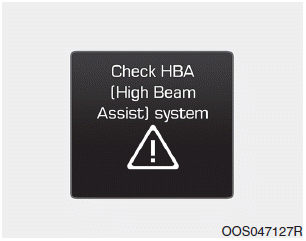
When the High Beam Assist (HBA)
System is not working properly, the
warning message will come on for a
few second. After the message disappears,
the master warning light ( )
will illuminate.
)
will illuminate.
